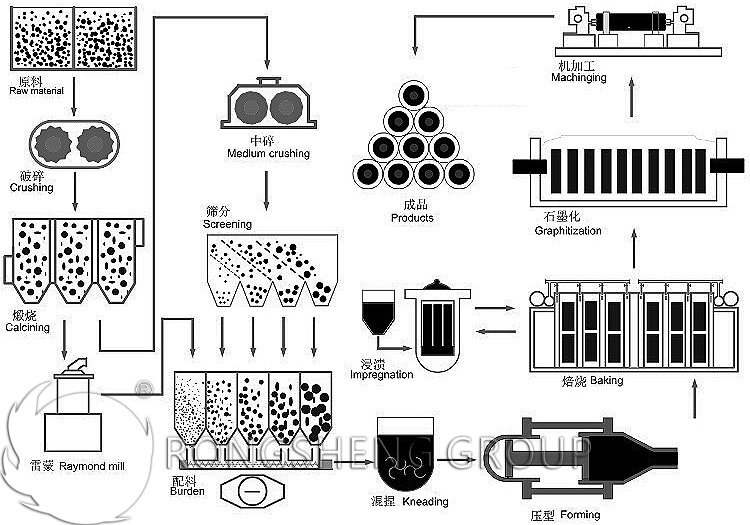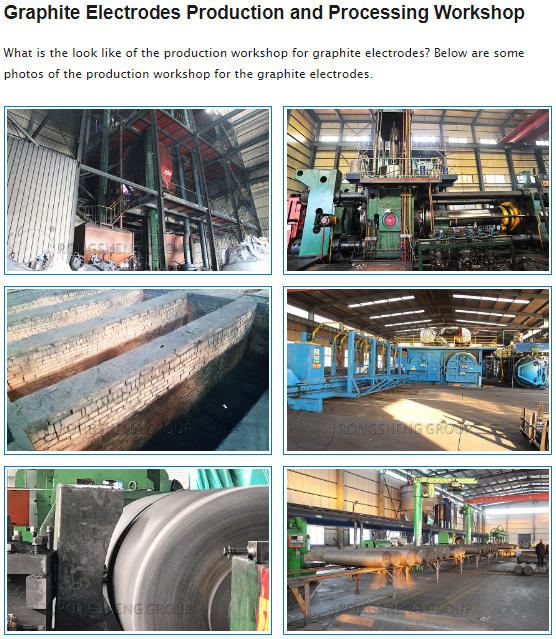The main raw material for graphite electrode production is petroleum coke. Ordinary power graphite electrodes can be added with a small amount of pitch coke, and the sulfur content of petroleum coke and pitch coke cannot exceed 0.5%. Needle coke is also needed when producing high-power or ultra-high-power graphite electrodes. The following lists the production characteristics of graphite electrodes.

- There are many production processes. The production process includes raw material calcination, crushing and grinding, batching, kneading, molding, roasting, impregnation, graphitization, and mechanical processing. Its production requires many special mechanical equipment and kilns with special structures. The construction investment is relatively large, and the investment recovery period is long.
- Long production cycle. The production cycle of ordinary power graphite electrodes is about 45 days. The production cycle of ultra-high-power graphite electrodes is more than 70 days. The production cycle of graphite electrode joints that require multiple dipping is longer.
- Higher energy consumption. It takes about 6000kw·h to produce the 1t ordinary power graphite electrode. Thousands of cubic meters of gas or natural gas. The metallurgical coke particles and metallurgical coke powder are about 1t.
- Petroleum coke and coal pitch, etc., as the carbon raw materials needed for the production, are by-products produced and processed for oil refineries and coal chemical companies. The quality and stability of raw materials cannot be fully guaranteed. In particular, needle coke for the production of high-power and ultra-high-power graphite electrodes, modified electrode pitch, and special impregnant pitch with low quinoline insoluble content. There is an urgent need for the attention and active cooperation of my country’s petroleum and coal chemical processing enterprises.
- A certain amount of dust and harmful gases are generated during the production process. It is necessary to adopt perfect ventilation and dust reduction and environmental protection measures to eliminate harmful gases.

Rongsheng Group, supplier of graphite electrodes. Provide high-quality graphite electrodes for electric arc furnace steelmaking. Contact us for more details of the production characteristics of graphite electrodes.
FAQ1 What are the characteristics of needle coke?
Needle coke is a high-quality carbon raw material, divided into coal-based and oil-based. The surface shows obvious strip lines, and most of them are long needle-shaped fragments when broken. The fibrous structure can be observed under the microscope, so it is called needle coke. Needle coke is easy to graphitize at a high temperature above 2000 degrees. Graphite electrodes made with it have low electrical resistivity and high bulk density. Moreover, the coefficient of thermal expansion is relatively small, making it an essential raw material for the production of ultra-high-power electrodes and high-power electrodes. The price of needle coke is much more expensive than that of ordinary coke and is currently about 5-8 times higher.
FAQ2 How long does the production cycle of graphite electrodes take?
The production process and corresponding time for a batch of ultra-high power or high power graphite electrodes are as follows. Electrode pressure type (3 days)-roasting (25 days)-immersion (4 days)-re-roasting (15 days)-graphitization (10 days)-machining, quality inspection (2 days). The finished product is packaged and shipped (1 day). That is, the fastest non-stop period in production from feeding to product shipment takes 60 days. Since the production of electrode joints requires more two-immersion and three-baking treatment than electrodes, the fastest production cycle is 90 days.
FAQ3 How to avoid electrode consumption increase during steelmaking?
When steelmaking, avoid the increase of electrode consumption. (1) Maintain a good power supply state, and send electricity within the range of electrode current intensity according to the design requirements of the electric furnace. (2) Prevent the arc starting point from immersing in the molten pool. (3) Prevent the electrode from being immersed in molten steel to increase carbon. (4) If conditions permit, the electrode adopts spray cooling technology. (5) Set up the correct exhaust emission system. (6) Use the correct oxygen blowing system.

